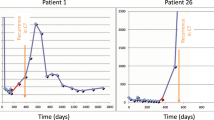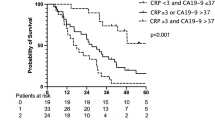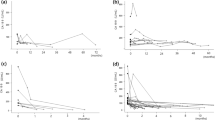Abstract
Thirty-nine patients with inoperable adenocarcinoma of the pancreas were studied (27 male, 12 female; median age 60 years, range 39-75 years). All patients received chemotherapy with continuous infusion 5-fluorouracil with intravenous bolus epirubicin followed by cisplatin, repeated every 21 days for a total of six cycles and were evaluable for response. Serum CA19-9 concentrations were obtained at baseline and before each cycle. A rise or fall in the tumour marker was defined as a greater than 15% increase or decrease in the marker on two consecutive occasions 3 weeks apart. A plateau in the tumour marker was defined as a less than 15% decrease or increase on two occasions. Changes in marker expression were compared with serial computerized tomography scanning before treatment and after the third and sixth cycle of chemotherapy. Thirty-five of 39 patients had an elevated CA19-9 (87.9%). Thirteen (36.2%) exhibited a decrease, seven (19.4%) a plateau and 16 (44.4%) patients had a progressive rise in serum CA19-9. The sensitivity of CA19-9 was 67% for predicting a partial response and 86% for progressive disease. The median survival for the 13 patients exhibiting a reduction was 333 days, for the seven patients exhibiting a plateau 253 days and for those who had a progressive rise 185 days. The difference in median survival between the group of patients with > 15% decrease and those with > 15% increase of CA19-9 was significant (P = 0.001). In the cohort of patients who exhibited a reduction in CA19-9, no tumour progression was seen, and the reduction occurred during the first three cycles of treatment. Thus, interval scanning may be avoided in this group of patients.
This is a preview of subscription content, access via your institution
Access options
Subscribe to this journal
Receive 24 print issues and online access
$259.00 per year
only $10.79 per issue
Buy this article
- Purchase on Springer Link
- Instant access to full article PDF
Prices may be subject to local taxes which are calculated during checkout
Similar content being viewed by others
Author information
Authors and Affiliations
Rights and permissions
About this article
Cite this article
Gogas, H., Lofts, F., Evans, T. et al. Are serial measurements of CA19-9 useful in predicting response to chemotherapy in patients with inoperable adenocarcinoma of the pancreas?. Br J Cancer 77, 325–328 (1998). https://doi.org/10.1038/bjc.1998.50
Issue Date:
DOI: https://doi.org/10.1038/bjc.1998.50
This article is cited by
-
Predictive Value of Serum Carbohydrate Antigen 19-9 (CA19-9) for Early Mortality in Advanced Pancreatic Cancer
Journal of Gastrointestinal Cancer (2018)
-
CA19-9-related tumor kinetics after first-line chemotherapy of patients with advanced pancreatic cancer: a monoinstitutional experience
Medical Oncology (2016)
-
Serum CA19-9 is a Significant Predictor among Preoperative Parameters for Early Recurrence after Resection of Pancreatic Adenocarcinoma
Journal of Gastrointestinal Surgery (2012)
-
Serum CA 19-9 as a Biomarker for Pancreatic Cancer—A Comprehensive Review
Indian Journal of Surgical Oncology (2011)
-
Comparison of standard-dose and low-dose gemcitabine regimens in pancreatic adenocarcinoma patients: a prospective randomized trial
Journal of Gastroenterology (2006)



